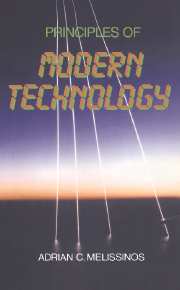Preface
Published online by Cambridge University Press: 03 December 2009
Summary
Ours is the age of technology, rivaling the industrial revolution in its impact on the course of civilization. Whether the great achievements of technology, and our dependence on them, have improved our lot, or lead inexorably to a ‘strange new world’ we shall not debate here. Instead we focus on the physical laws that make technology possible in the first place. Our aim is to understand and explain modern technology, as distinct from describing it.
Even when the principles underlying a technical process or device are well understood, a great deal of engineering effort and a long manufacturing infrastructure are needed to translate them into practice. In turn, the technical skills that are developed lead to new possibilities in basic research and to new applications. For instance, the laser could have been easily built at the turn of the century; yet it was a long road starting with the development of radar and followed by the invention of the maser that led to the proposal for the laser. The use of computers in so many manufacturing areas and research fields is another example of the interplay between technology and basic science.
Because of the complexity of modern devices and of the rapid advances in all scientific fields, the need for specialization is acute. Thus, often, science students are only vaguely aware of the applications of the principles they have learned, whereas engineering students are too involved to appreciate the power of the physical law.
- Type
- Chapter
- Information
- Principles of Modern Technology , pp. xi - xiiiPublisher: Cambridge University PressPrint publication year: 1990



